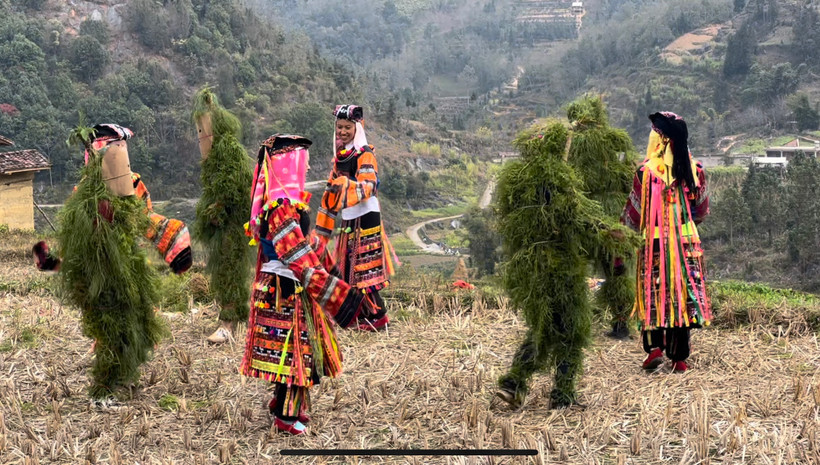Dancing with the grass ghost is a unique spiritual tradition found only in the ancestral worship rituals of the Lo Lo ethnic group in Lung Cu commune, Dong Van district (Ha Giang province).
Deeply symbolic and humanistic, the ritual reflects the Lo Lo belief that it serves as a sacred link between the departed and their descendants on Earth.

According to shaman Sing Di Trai in Lung Cu, the grass ghost represents the ancestors - those who founded the village and once clothed themselves in forest leaves.
In every ancestral ceremony, the presence of the grass ghost is indispensable, acting as the spirit guide.
While all Lo Lo families have ancestral altars, the ceremonies are always held at the home of the clan leader, who takes responsibility for preparing offerings, inviting the shaman, borrowing the sacred bronze drums, and requesting the presence of a skilled drum performer.
Bronze drums, revered as sacred treasures of the Lo Lo community, must always include both a large drum (female drum) and a smaller one (male drum).
As the clan leader prepares the offerings - which include a chicken, three cups of rice wine, sticky rice, fruits, votive paper, and coins - young men venture into the Chun Ta mountain (also called “Spine Ridge”) to collect fresh, soft Su Choeo grass.
This is used to weave the costume of the forest spirit, also known as the grass ghost (Gha Lu Ngang). Meanwhile, Lo Lo women prepare traditional garments adorned with rows of buttons stitched vertically along hats and shirts, symbolizing unity and communal harmony.
The ceremony includes three key rituals: the offering, the remembrance, and the farewell.
Once the shaman completes prayers seeking blessings for health, happiness, academic success, and agricultural prosperity, the drum performance begins.
Women in traditional dress dance rhythmically to the drumbeats to welcome the arrival of the grass ghost.
The grass ghost is transformed at a secluded spot outside the village.
Their body is covered with layers of Su Choeo grass, and they wear a mask revealing only the eyes and mouth.
A maternal uncle or son-in-law of the host family invites the spirit to the ceremony.
On the way to the site, no one is allowed to look directly at the grass ghost or cross its path - only from a distance.
Upon arrival, the grass ghost bows three times before the ancestral altar and then to the shaman, marking the start of the dance ritual.
The person playing the role must be in good health and carry a strong sense of duty, as they must perform non-stop until the remembrance rite ends - typically around 5 PM - without speaking, eating, or tripping.
A stumble or being recognized is believed to bring misfortune to the host family for the entire year. Only at noon are they allowed to briefly rest and eat, and they may drink water offered by the host during the ritual.
At the end of the ceremony, the grass ghost bows once more before the altar, the shaman, and the drums, then quietly exits through the village gate.
They return to a hidden area behind the village to remove their costume in complete privacy. After cleansing and changing, they rejoin the ceremony for the nighttime farewell ritual honoring the ancestors.
PV